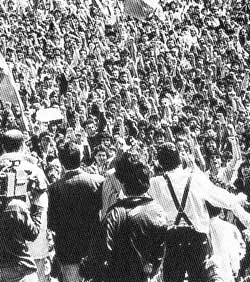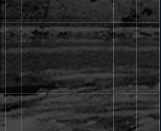
Inti-Illimani's
return to Chile, September 1988.
Photo Copyright © Música Popular Chilena –
20 Años 1970-1990 Edited by Alvaro Godoy and Juan
Pablo González |
PATRICIO
LANFRANCO, composer, singer
At the time of the coup, in 1973, I was in my second year of Chemical
Engineering at the University of Concepción, a school categorized
during that period as the Red University of Chile. It was a progressive
university, with 23,000 students, where basically two or three organizations
headed up the student movement: MIR [Movimiento de Izquierda
Revolucionaria (Revolutionary Left Movement)], the Socialist
Youth and the Communist Youth. Our focus was to maintain direct
access to the progressive cultural movements and a clear connection
with Santiago.
After the coup I spent six or seven months living underground in
Quilpué, a small inland town near Viña del Mar. I
didn’t dare go to Santiago until much later. I was a member
of the Communist Youth and had a close relationship with Party members.
They were very accessible people who would come to your house to
talk and discuss issues. You felt a participant of an historic,
interesting movement that was part of your life, part of the common
experience.
Chile in 1973 had a very solid artistic movement. It had the New
Chilean Song; it had a theater movement and a new painting school.
Art concepts had changed in 1968 and 1969, when on one hand, Matta’s
influence appeared everywhere and on the other, painting went to
the streets and became murals. The political brigades who painted
the murals, even the brigades of the Right, competed for walls to
campaign for their candidates. Cities, like Concepción and
Valparaíso, were characterized by their murals. They were
cities of colors. Then the military painted over the walls, and,
for a long time after the coup, the walls were gray.
Fortunately,
the biggest exponents of Chilean music were on tour in Europe when
the military coup happened. The Quilapayún, for example,
was abroad; so was Isabel Parra; so was Patricio Manns, the Inti-Illimani,
all of them. And they stayed abroad in exile. The same in the field
of painting, in the field of poetry. Lucky for them. But that meant
that the generation immediately following them were without mentors,
without people who could orient them in cultural matters, without
people to talk to, go to a bar with and sit down and argue and dialogue
and soak up what they had to teach.
|
|


